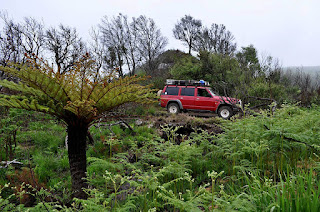Był 22 październik i właśnie mijało pół roku od naszego wyjazdu z Polski. Uczciliśmy to siedząc cały dzień w mieszczącej się w budynku muzeum kawiarni, w mieście Bulawayo. Zwiedziliśmy też muzeum i podziwialiśmy jego zbiory sztuki współczesnej. Następnego dnia pojechaliśmy do centrum na zakupy. Zostawiliśmy samochód na ulicy i gdy po krótkiej wizycie w sklepie wróciliśmy do niego usłyszałem głośny syk powietrza. Ktoś przebił bok opony prawdopodobnie po to by móc nas okraść w momencie zmiany koła. Odjechałem kawałek na główną ulicę i rozglądając się dookoła zabrałem się za zdejmowanie zapasu. Po chwili pojawił się przy nas jegomość który stanął obok naszego samochodu i udawał, że się w ogóle nami nie interesuje. Wziąłem do ręki duży klucz, chwilę popatrzyliśmy sobie w oczy po czym nasz złoczyńca zrezygnował i odszedł. Później pomyślałem, że mogłem mu przyłożyć za zniszczoną oponę i za to, że w wielkim skwarze musiałem zmieniać koła.
Tego dnia dojechaliśmy do Parku Narodowego Matopos, gdzie spędziliśmy kolejne dwie noce. Magiczna kraina, która tak zauroczyła Rhodes’a, że zakupił tu kilkadziesiąt tysięcy hektarów ziemi i wybrał to ją na miejsce swojego ostatniego spoczynku. Poruszając się pomiędzy fantazyjnymi skalnymi formacjami cieszyliśmy oczy i raczyliśmy dusze nieskalaną ludzką ręką naturą. Cieszyliśmy się, że miejsca takie jak to chroni się przed największymi dewastatorami – ludźmi i przez głowy przeszła nam myśl, że być może świat nie zwariował do końca i wszyscy zrozumiemy, że potrzebujemy świeżego oddechu, bo ciężko być szczęśliwym i zdrowym żyjąc otoczonym betonowymi bunkrami.
Bulawayo and Matopos
It was the 22nd of October, marking the end of six months since we’d left Poland. We celebrated by spending the entire day in Bulawayo’s National Gallery, firstly admiring its collection of modern art and then whiling away the rest of the day sampling the homemade fare in the gallery’s excellent café. The following day we set about doing some shopping in the town centre, parking our vehicle on a busy street. We returned after no more than 20 minutes to the sound of loud hissing emanating from one of the car’s wheels; someone had driven a knife into the tyre wall, presumably in an attempt to see what they could pilfer whilst we were distracted with having to change the wheel. There was enough air left in the tyre to drive a short distance to the city’s main thoroughfare, where Adam began to remove one of the spare wheels. Shortly afterwards a young fellah turned up and casually stood alongside our car trying his best to look completely uninterested in us. Wielding an enormous spanner in his hand and looking as irate as a man who has just had one of his tyres slashed and is having to change a 32” wheel in sweltering conditions, Adam stared intently at the would-be felon, who quickly realised that it wouldn’t be worth his while to hang around and promptly walked away.
That same day we drove across to the Matopos National Park, where we spent the next two nights. This magical land so enchanted Cecil Rhodes that he bought up several thousand hectares of it and chose it as his final resting place. Wandering around through the park’s fantastic rock formations was an immense feast for the senses and felt hugely uplifting. It’s good to know that places such as this are protected from the greatest of devastating forces – humans; perhaps, after all, the world hasn’t gone completely mad and we do all realise that we need space to breathe, and that health and happiness are difficult to achieve living amidst concrete bunkers.
It was the 22nd of October, marking the end of six months since we’d left Poland. We celebrated by spending the entire day in Bulawayo’s National Gallery, firstly admiring its collection of modern art and then whiling away the rest of the day sampling the homemade fare in the gallery’s excellent café. The following day we set about doing some shopping in the town centre, parking our vehicle on a busy street. We returned after no more than 20 minutes to the sound of loud hissing emanating from one of the car’s wheels; someone had driven a knife into the tyre wall, presumably in an attempt to see what they could pilfer whilst we were distracted with having to change the wheel. There was enough air left in the tyre to drive a short distance to the city’s main thoroughfare, where Adam began to remove one of the spare wheels. Shortly afterwards a young fellah turned up and casually stood alongside our car trying his best to look completely uninterested in us. Wielding an enormous spanner in his hand and looking as irate as a man who has just had one of his tyres slashed and is having to change a 32” wheel in sweltering conditions, Adam stared intently at the would-be felon, who quickly realised that it wouldn’t be worth his while to hang around and promptly walked away.
That same day we drove across to the Matopos National Park, where we spent the next two nights. This magical land so enchanted Cecil Rhodes that he bought up several thousand hectares of it and chose it as his final resting place. Wandering around through the park’s fantastic rock formations was an immense feast for the senses and felt hugely uplifting. It’s good to know that places such as this are protected from the greatest of devastating forces – humans; perhaps, after all, the world hasn’t gone completely mad and we do all realise that we need space to breathe, and that health and happiness are difficult to achieve living amidst concrete bunkers.
























